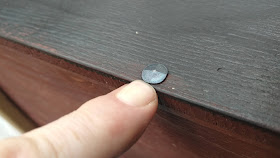 |
| Ta-daaaaa! |
 |
| Feed-N-Wax |
The consistency of this product is a little more liquid-y than what I make. It seemed to work well, though, and it is very easy to apply this way. What I did was squirt a glob in the middle of a cloth, wrap the cloth around it, and use the cloth as an applicator. After letting it sit for 10-15 minutes, I buff it out with a clean cloth.
I like the look.
Now that the finish is done, let's get rid of those ugly drywall screws and replace them with roman nails. Unfortunately the only Roman nails I happened to have are 60mm long, about 2 1/2" or so. Total overkill for this, but it's what I have.
 |
| Out with the old... |
 |
| In with the new! |
This engineered hardwood is much more fragile than solid 3/4" pine, so I had to be very careful. Most of the screws I backed out left a hole big enough that I could push the nail in with finger pressure until less of an inch of the nail was sticking out.
 |
| Notice a Roman nail makes a good hammer handle wedge. |
It's just then a matter of carefully tapping the nail home.
 |
| But not too far! |
I've learned the hard way that if you keep banging on these nails, the head will crush the wood fibers around it, spoiling a nice paint job. One only needs to tap until the sound changes. I check it is deep enough if I'm unable to get a fingernail under the head of the nail.
 |
| One minor blowout. |
There were only two nails that decided to misbehave. One is pictured above, it blew out on the underside of the center shelf. It's not too bad, and it's in a hidden place, so I left it be. The other was on a corner with a dovetail. Remember, I reinforced my dovetails with nails, and I think this reinforcing nail pushed my Roman nail out of the way. While I was tapping it home, I noticed it started to come out of the bottom of the chest. Since I still had little way to go with the nail, I decided to remove the nail and squirt some PVA glue in the wood that was deforming. I then nipped an inch of length off the nail with some nippers, and pounded the nail in. Good as new.
 |
| My method of clenching nails in a single photo. |
I decided to attach the battens on the fall front with clenched nails. I really like this technique. It holds forever, like it or not.
Now I can say I'm done with the carcass of the chest. Here's some glamour shots:
There's obviously a bit more to do, such as organize the top compartment to hold my leather working tools, add some handles on the sides, and maybe a lock. I might also decide to make another matching box for this one to sit on that is on casters. That would give me even more storage for stuff I didn't need that often, as well as making it easily transportable around my apartment.
Overall I'm extremely happy with this chest. I didn't really have high expectations for it. In fact, I figured it would be something that perhaps I would throw out someday and build again when I had better materials. But this box is surprisingly strong.
Someone asked about the weight. I'm not a very good judge, but I think it is probably similar to a chest made of pine. This one as it is weighs 13.4 kilograms ( about 30 pounds). Not too bad for a huge box.
The single best part of this chest for me is the finish. I toyed with the idea of turning the beech side out, but I figured the joints would bee too ugly and weird. I'm glad I chose this. I am stunned at how well those Japanese burnishers prepared the soft underside of the flooring material for milk paint. Sadly, it can't be properly displayed in photos. I find myself running my hands over the surface of the lid every time I walk by it.
The milk paint turned out so well, that I'm wondering what else I could make and finish this way. It just dawned on me that my ATC that I built in 2011 is still unpainted. Perhaps it would be fun to try red over black?
I look forward to many years of use from this tool chest. I hope you enjoyed the build half as much as I did.









































